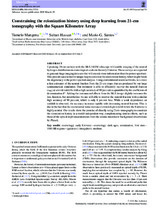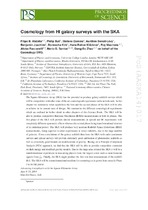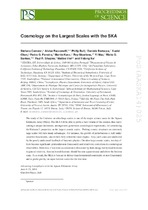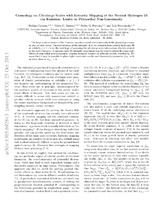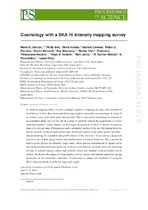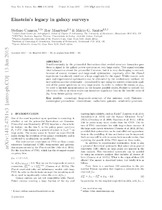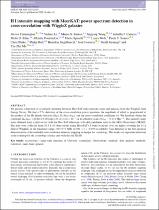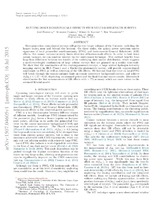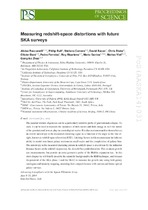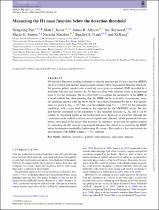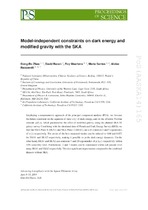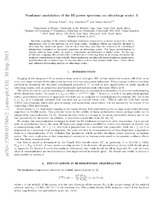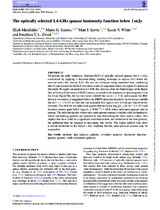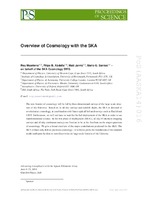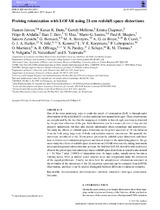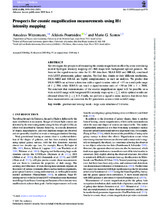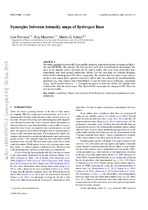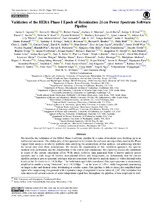Browsing by Author "Santos, Mario G."
Now showing items 1-18 of 18
-
Constraining the reionization history using deep learning from 21-cm tomography with the Square Kilometre Array
Mangena, Tumelo; Hassan, Sultan; Santos, Mario G. (Oxford University Press, 2020)Upcoming 21-cm surveys with the SKA1-LOW telescope will enable imaging of the neutral hydrogen distribution on cosmological scales in the early Universe. These surveys are expected to generate huge imaging data sets that ... -
Cosmology from HI galaxy surveys with the SKA
Maartens, Roy; Abdalla, Filipe B.; Bull, Philip; Camera, Stefano; Benoit-Levy, Aurelien; Joachimi, Benjamin; Kirk, Donnacha; Klöckner, Hans-Rainer; Raccanelli, Alvise; Santos, Mario G.; Zhao, Gong-Bo (Proceedings of Science, 2014)The Square Kilometer Array (SKA) has the potential to produce galaxy redshift surveys which will be competitive with other state of the art cosmological experiments in the next decade. In this chapter we summarise what ... -
Cosmology on the largest scales with the SKA
Camera, Stefano; Raccanelli, Alvise; Bull, Philip; Bertacca, Daniele; Chen, Xuelei; Ferreira, Pedro G.; Kunz, Martin; Maartens, Roy; Mao, Yi; Santos, Mario G.; Shapiro, Paul R.; Viel, Matteo; Xug, Yidong (Proceedings of Science, 2014)The study of the Universe on ultra-large scales is one of the major science cases for the Square Kilometre Array (SKA). The SKA will be able to probe a vast volume of the cosmos, thus representing a unique instrument, ... -
Cosmology on ultralarge scales with intensity mapping of the neutral hydrogen 21 cm emission: limits on primodial non-gaussianity
Camera, Stefano; Santos, Mario G.; Ferreira, Pedro G.; Ferramacho, Luis (American Physical Society, 2013)The large-scale structure of the Universe supplies crucial information about the physical processes at play at early times. Unresolved maps of the intensity of 21 cm emission from neutral hydrogen HI at redshifts z ~ 1 − ... -
Cosmology with a SKA HI intensity mapping survey
Santos, Mario G.; Bull, Philip; Alonso, David; Camera, Stefano; Ferreira, Pedro G.; Bernardi, Gianni; Maartens, Roy; Viel, Matteo; Villaescusa-Navarro, Francisco; Abdalla, Filipe B.; Jarvis, Matt; Metcalf, R. Benton; Pourtsidou, A.; Wolz, Laura (Proceedings of Science, 2014)HI intensity mapping (IM) is a novel technique capable of mapping the large-scale structure of the Universe in three dimensions and delivering exquisite constraints on cosmology, by using HI as a biased tracer of the ... -
Einstein's legacy in galaxy surveys
Camera, Stefano; Maartens, Roy; Santos, Mario G. (Oxford University Press, 2015)Non-Gaussianity in the primordial fluctuations that seeded structure formation produces a signal in the galaxy power spectrum on very large scales. This signal contains vital information about the primordial Universe, but ... -
H I intensity mapping with MeerKAT: Power spectrum detection in cross-correlation with WiggleZ galaxies
Cunnington, Steven; Li, Yichao; Santos, Mario G. (Oxford University Press, 2023)We present a detection of correlated clustering between MeerKAT radio intensity maps and galaxies from the WiggleZ Dark Energy Survey. We find a 7.7σ detection of the cross-correlation power spectrum, the amplitude of which ... -
Hunting down horizon-scale effects with multi-wavelength surveys
Fonseca, Jose; Camera, Stefano; Santos, Mario G.; Maartens, Roy (American Astronomical Society, 2015)Next-generation cosmological surveys will probe ever larger volumes of the universe, including the largest scales, near and beyond the horizon. On these scales, the galaxy power spectrum carries signatures of local primordial ... -
Measuring redshift-space distortion with future SKA surveys
Raccanelli, Alvise; Bull, Philip; Camera, Stefano; Bacon, David; Blake, Chris; Dore, Olivier; Ferreira, Pedro G.; Maartens, Roy; Santos, Mario G.; Viel, Matteo; Zhao, Gong-Bo (Proceedings of Science, 2014)The peculiar motion of galaxies can be a particularly sensitive probe of gravitational collapse. As such, it can be used to measure the dynamics of dark matter and dark energy as well the nature of the gravitational laws ... -
Measuring the HI mass function below the detection threshold
Pan, Hengxing; Jarvis, Matt J.; Santos, Mario G. (Royal Astronomical Society, 2020)We present a Bayesian stacking technique to directly measure the H I mass function (HIMF) and its evolution with redshift using galaxies formally below the nominal detection threshold. We generate galaxy samples over several ... -
Model-independent constraints on dark energy and modified gravity with the SKA
Zhao, Gong-Bo; Bacon, David; Maartens, Roy; Santos, Mario G.; Raccanelli, Alvise (Proceedings of Science, 2014)Employing a nonparametric approach of the principal component analysis (PCA), we forecast the future constraint on the equation of state w(z) of dark energy, and on the effective Newton constant m(k; z), which parameterise ... -
Nonlinear modulation of the HI power spectrum on ultra-large scales. I
Umeh, Obinna; Maartens, Roy; Santos, Mario G. (IOP Science, 2015)Intensity mapping of the neutral hydrogen brightness temperature promises to provide a three-dimensional view of the universe on very large scales. Nonlinear effects are typically thought to alter only the small-scale ... -
The optically selected 1.4-GHz quasar luminosity function below 1 mJy
Malefahlo, Eliab; Santos, Mario G.; Jarvis, Matt J; White, Sarah V.; Zwart, Jonathan T. L. (Oxford University Press, 2020)We present the radio luminosity function (RLF) of optically selected quasars below 1 mJy, constructed by applying a Bayesian-fitting stacking technique to objects well below the nominal radio flux density limit. We test ... -
Overview of Cosmology with the SKA
Maartens, Roy; Abdalla, Filipe B.; Jarvis, Matt; Santos, Mario G. (Proceedings of Science, 2014)The new frontier of cosmology will be led by three-dimensional surveys of the large-scale structure of the Universe. Based on its all-sky surveys and redshift depth, the SKA is destined to revolutionize cosmology, in ... -
Probing reionization with LOFAR (Low Frequency Array) using 21-cm redshift space distortions
Jensen, Hannes; Datta, Kanan K.; Santos, Mario G.; Mellema, Garrelt; Chapman, Emma; Abdalla, Filipe B.; Iliev, Ilian T.; Mao, Yi; Shapiro, Paul R.; Zaroubi, Saleem; Bernardi, Gianni; Brentjens, M. A.; de Bruyn, A. G.; Ciardi, B.; Harker, G. J. A.; Jelić, V.; Kazemi, S.; Koopmans, L. V. E.; Labropoulos, P.; Martinez, O.; Offringa, A. R.; Pandey, V. N.; Schaye, J.; Thomas, R. M.; Veligatla, V.; Vedantham, H.; Yatawatta, S. (Oxford University Press, 2013)One of the most promising ways to study the epoch of reionization (EoR) is through radio observations of the redshifted 21-cm line emission from neutral hydrogen. These observations are complicated by the fact that the ... -
Prospects for cosmic magnification measurements using H I intensity mapping
Witzemann, Amadeus; Pourtsidou, Alkistis; Santos, Mario G. (Oxford University Press, 2020)We investigate the prospects of measuring the cosmic magnification effect by cross-correlating neutral hydrogen intensity mapping (H I IM) maps with background optical galaxies. We forecast the signal-to-noise ratio for ... -
Synergies between intensity maps of hydrogen lines
Fonseca, Jose; Maartens, Roy; Santos, Mario G. (Oxford University Press, 2018)We study synergies between Hi 21cm and Hα intensity map observations, focusing on SKA1- like and SPHEREx-like surveys. We forecast how well such a combination can measure features in the angular power spectrum on the ... -
Validation of the hera phase i epoch of reionization 21 cm power spectrum software pipeline
Aguirre, James E.; Murray, Steven G.; Santos, Mario G. (IOP Publishing, 2022)We describe the validation of the HERA Phase I software pipeline by a series of modular tests, building up to an end-to-end simulation. The philosophy of this approach is to validate the software and algorithms used in ...

